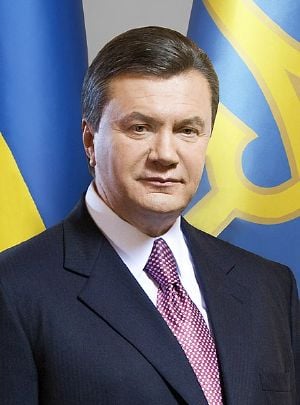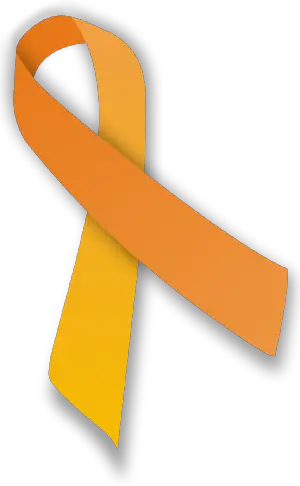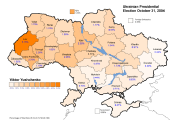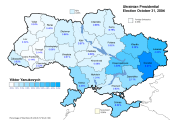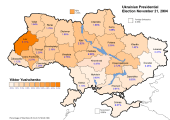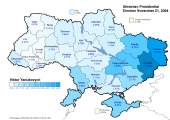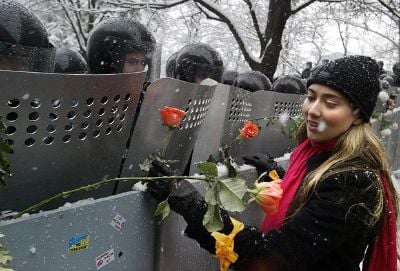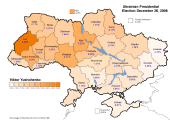Orange Revolution
| Orange Revolution | |||
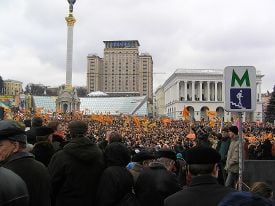 Orange-clad demonstrators gather in the Independence Square in Kyiv on November 22, 2004 | |||
| Date | November 22, 2004 ‚Äď January 23, 2005 | ||
|---|---|---|---|
| Caused by |
| ||
| Goals | |||
| Methods | Demonstrations, civil disobedience, civil resistance, strike actions | ||
| Resulted in | |||
| Parties to the civil conflict | |||
| Lead figures | |||
| |||
| Numbers | |||
| Casualties and Losses | |||
| Death(s) | 1 man died from a heart attack | ||
The Orange Revolution (Ukrainian: –ü–ĺ–ľ–į—Ä–į–Ĺ—á–Ķ–≤–į —Ä–Ķ–≤–ĺ–Ľ—é—Ü—Ė—Ź) was a series of protests and political events that took place in Ukraine from late November 2004 to January 2005 in the immediate aftermath of the run-off vote of the 2004 Ukrainian presidential election. Claims of massive corruption, voter intimidation and electoral fraud were alleged. Kyiv, the Ukrainian capital, was the focal point of the movement's campaign of civil resistance, with thousands of protesters demonstrating daily. The revolution was highlighted by a series of nationwide acts of civil disobedience, sit-ins, and general strikes organized by the opposition movement.
The protests were prompted by reports from several domestic and foreign election monitors as well as the widespread public perception that the results of the run-off vote of November 21, 2004 between leading candidates Viktor Yushchenko and Viktor Yanukovych were rigged by the authorities in favor of the latter. The nationwide protests succeeded when the results of the original run-off were annulled, and a revote was ordered by Ukraine's Supreme Court for 26 December 2004. Under intense scrutiny by domestic and international observers, the second run-off was declared to be "free and fair." The final results showed a clear victory for Yushchenko, who received about 52 percent of the vote, compared to Yanukovych's 45 percent. Yushchenko was declared the official winner and with his inauguration on January 23, 2005 in Kyiv, the Orange Revolution ended.
Background
Gongadze assassination/ the Kuchmagate crisis
Georgiy Gongadze, a Ukrainian journalist and the founder of Ukrayinska Pravda (an Internet newspaper well known for publicizing the corruption or unethical conduct of Ukrainian politicians) was kidnapped and murdered in 2000. Persistent rumors suggested that Ukrainian President Kuchma ordered the killing. Gen. Oleksiy Pukach, a former police officer, was accused of the murder under the orders of a former minister who committed suicide in 2005. Pukach was arrested in 2010[4] and was sentenced to life in prison in 2013.[5] This murder sparked a movement against Kuchma in 2000 that can be seen as the origin of the Orange Revolution in 2004. After two terms of presidency (1994-2005) and the Cassette Scandal of 2000 that ruined his image irreparably, Kuchma decided not to run for a third term in the 2004 elections and instead supported Prime Minister Viktor Yanukovych in the presidential race against Viktor Yushchenko of the Our Ukraine‚ÄďPeople's Self-Defense Bloc.
Factors contributing to the Orange Revolution
The state of Ukraine during the 2004 presidential election is considered an "ideal condition" for an outburst from the public. During this time Ukrainians were impatient while waiting for the economic and political transformation.[6] The results of the election were thought to be fraudulent. The Ukrainian regime that was in power before the Orange Revolution created a path for a democratic society to emerge. It was based on a "competitive authoritarian regime" that is considered a "hybrid regime", allowing for a democracy and market economy to come to life. The election fraud emphasized the Ukrainian citizens' desire for a more pluralistic type of government.
The Cassette Scandal sparked the public's desire to create a social reform movement. It not only undermined the peoples' respect for Kuchma as a president, but also for the elite ruling class in general. Because of Kuchma's scandalous behaviour, he lost many of his supporters with high ranking government positions. Many of the government officials who were on his side went on to fully support the election campaign of Yushchenko as well as his ideas in general.
After a clear lack of faith in the government had been instilled in the Ukrainian population, Yushchenko's role had never been more important to the revolution. Yushchenko was a charismatic candidate who showed no signs of being corrupt. Yuschenko was on the same level as his constituents and presented his ideas in a "non-Soviet" way. Young Ukrainian voters were extremely important to the outcome of the 2004 Presidential election. This new wave of younger people had different views of the main figures in Ukraine. They were exposed to a lot of negativity from the Kuchmagate and therefore had very skewed visions about Kuchma and his ability to lead their country.
The abundance of younger people who participated showed an increasing sense of nationalism that was developing in the country. The Orange Revolution had enough popular impact that it interested people of all ages.[7]
Prelude to the Orange Revolution
Political alliances
In late 2002, Viktor Yushchenko (Our Ukraine), Oleksandr Moroz (Socialist Party of Ukraine), Petro Symonenko (Communist Party of Ukraine) and Yulia Tymoshenko (Yulia Tymoshenko Bloc) issued a joint statement concerning "the beginning of a state revolution in Ukraine."[8] The communists left the alliance. Symonenko opposed the idea of a single candidate from the alliance in the Ukrainian presidential election of 2004; but the other three parties remained allied[9] until July 2006.[10] (In the autumn of 2001 both Tymoshenko and Yushchenko had broached the idea of setting up such a coalition.
On July 2, 2004 Our Ukraine and the Yulia Tymoshenko Bloc established the Force of the People, a coalition which aimed to stop "the destructive process that has, as a result of the incumbent authorities, become a characteristic for Ukraine" - President Leonid Kuchma and Prime Minister Viktor Yanukovych were the "incumbent authorities" that she referenced. The pact included a promise by Viktor Yushchenko to nominate Tymoshenko as Prime Minister if Yushchenko won the October 2004 presidential election.[11]
2004 Ukraine presidential election campaign
The 2004 presidential election in Ukraine eventually featured two main candidates:
- sitting Prime Minister Viktor Yanukovych, largely supported by Leonid Kuchma (the outgoing President of Ukraine who had already served two terms in office from 1994 and was precluded from running himself due to constitutional term limits)
- the opposition candidate Viktor Yushchenko, leader of the Our Ukraine faction in the Ukrainian parliament and a former Prime Minister (1999‚Äď2001)
The election took place in a highly charged atmosphere, with the Yanukovych team and the outgoing president's administration using their control of the government and state apparatus for intimidation of Yushchenko and his supporters. In September 2004 Yushchenko suffered dioxin poisoning under mysterious circumstances. While he survived and returned to the campaign trail, the poisoning undermined his health and altered his appearance dramatically (his face remains disfigured by the consequences).
The two main candidates were neck and neck in the first-round vote held on October 31, 2004, with Yanulovych winning 39.32 percent and Yushchenko gaining 39.87 percent of the votes cast. The candidates who came third and fourth collected much less: Oleksandr Moroz of the Socialist Party of Ukraine and Petro Symonenko of the Communist Party of Ukraine received 5.82 percent and 4.97 percent, respectively. Since no candidate had won more than 50 percent of the cast ballots, Ukrainian law mandated a run-off vote between two leading candidates. After the announcement of the run-off, Oleksandr Moroz threw his support behind Viktor Yushchenko. The Progressive Socialist Party's Natalia Vitrenko, who won 1.53 percent of the vote, endorsed Yanukovych, who hoped for Petro Simonenko's endorsement but did not receive it.
In the wake of the first round of the election, many complaints emerged regarding voting irregularities in favor of the government-supported Yanukovych. However, as it was clear that neither nominee was close enough to collecting an outright majority in the first round, challenging the initial result would not have affected the outcome of the round. So the complaints were not actively pursued and both candidates concentrated on the upcoming run-off scheduled for November 21.
Pora! activists were arrested in October 2004, but the release of many (reportedly on President Kuchma's personal order) gave growing confidence to the opposition.[12]
Yushchenko's supporters originally adopted orange as the signifying color of his election campaign. Later, the color gave its name to an entire series of political labels, such as the Oranges (Pomaranchevi in Ukrainian) for his political camp and its supporters. At the time when the mass protests grew, and especially when they brought about political change in the country, the term Orange Revolution came to represent the entire series of events.
In view of the success of using color as a symbol to mobilize supporters, the Yanukovych camp chose blue for themselves.
Protests
Protests began on the eve of the second round of voting, as the official count differed markedly from exit poll results which gave Yushchenko up to an 11 percent lead, while official results gave the election win to Yanukovych by 3 percent. While Yanukovych supporters have claimed that Yushchenko's connections to the Ukrainian media explain this disparity, the Yushchenko team publicized evidence of many incidents of electoral fraud in favor of the government-backed Yanukovych, witnessed by many local and foreign observers.[13] These accusations were reinforced by similar allegations, though at a lesser scale, during the first presidential run of October.[14][15]
The Yushchenko campaign publicly called for protest on the dawn of election day, November 21, 2004, when allegations of fraud began to spread in the form of leaflets printed and distributed by the 'Democratic Initiatives' foundation, announcing on the basis of its exit poll that Yushchenko had won. Beginning on November 22, 2004, massive protests started in cities across Ukraine:[16] the largest, in Kyiv's Maidan Nezalezhnosti (Independence Square), 31 attracted an estimated 500,000 participants,[17] who on November 23, 2004, peacefully marched in front of the headquarters of the Verkhovna Rada, the Ukrainian parliament, many wearing orange or carrying orange flags in support of Yushchenko's campaign coalition. One of the most prominent activists of that time was Paraska Korolyuk, subsequently bestowed with the Order of Princess Olga. From November 22 Pora! undertook the management of the protests in Kyiv until the end of the demonstration.[1]
The local councils in Kyiv, Lviv,[18] and several other cities passed a largely symbolic refusal to accept the legitimacy of the official election results with the wide popular support of their constituency, and Yushchenko took a symbolic presidential oath.[19] This "oath" taken by Yushchenko in half-empty parliament chambers lacked a quorum as only the Yushchenko-leaning factions were present. In any case, it was not legally-binding, but it was an important symbolic gesture meant to demonstrate the resolve of the Yushchenko campaign not to accept the compromised election results. In response, Yushchenko's opponents denounced him for taking an illegitimate oath, and even some of his moderate supporters were ambivalent about this act, while a more radical side of the Yushchenko camp demanded him to act even more decisively. Some observers argued that this symbolic presidential oath might have been useful to the Yushchenko camp should events have taken a more confrontational route. In such a scenario, this "presidential oath" Yushchenko took could be used to lend legitimacy to the claim that he, rather than his rival who tried to gain the presidency through alleged fraud, was a true commander-in-chief authorized to give orders to the military and security agencies.
At the same time, local officials in Eastern and Southern Ukraine, the stronghold of Viktor Yanukovych, started a series of actions alluding to the possibility of the breakup of Ukraine or an extra-constitutional federalization of the country, should their candidate's claimed victory not be recognized. Demonstrations of public support for Yanukovych were held throughout Eastern Ukraine and some of his supporters arrived in Kyiv. In Kyiv the pro-Yanukovych demonstrators were far outnumbered by Yushchenko supporters, whose ranks were continuously swelled by new arrivals from many regions of Ukraine. The scale of the demonstrations in Kyiv was unprecedented. By many estimates, on some days they drew up to one million people to the streets, in freezing weather.[20]
In total 18.4 percent of Ukrainians have claimed to have taken part in the Orange Revolution (across Ukraine).[1]
Political developments
Although Yushchenko entered into negotiations with outgoing President Leonid Kuchma in an effort to peacefully resolve the situation, the negotiations broke up on November 24, 2004. Yanukovych was officially certified as the victor by the Central Election Commission, which itself was allegedly involved in falsification of electoral results by withholding the information it was receiving from local districts and running a parallel illegal computer server to manipulate the results. The next morning after the certification took place, Yushchenko spoke to supporters in Kyiv, urging them to begin a series of mass protests, general strikes and sit-ins with the intent of crippling the government and forcing it to concede defeat.
In view of the threat of illegitimate government ascending to power, Yushchenko's camp announced the creation of the Committee of National Salvation which declared a nationwide political strike.
On December 1, 2004, the Verkhovna Rada passed a resolution that strongly condemned pro-separatist and attempts at federalization, and passed a no-confidence vote in the Cabinet of Ministers of Ukraine, a decision Prime Minister Yanukovych refused to recognize. By the Constitution of Ukraine, the no-confidence vote mandated the government's resignation, but the parliament had no means to enforce a resignation without the co-operation of Prime Minister Yanukovych and outgoing President Kuchma.
On December 3, 2004, Ukraine's Supreme Court finally broke the political deadlock. The court decided that due to the scale of the electoral fraud it was impossible to establish the election results. It invalidated the official results that would have given Yanukovych the presidency. As a resolution, the court ordered a revote of the run-off to be held on December 26, 2004.[21] This decision was seen as a victory for the Yushchenko camp while Yanukovych and his supporters favored a rerun of the entire election rather than just the run-off. On December 8, 2004 the parliament amended laws to provide a legal framework for the new round of elections. The parliament also approved the changes to the Constitution, implementing a political reform backed by outgoing President Kuchma as a part of a political compromise between the acting authorities and opposition.
In November 2009 Yanukovych stated that although his victory in the elections was "taken away," he gave up this victory in order to avoid bloodshed. "I didn't want mothers to lose their children and wives their husbands. I didn't want dead bodies from Kyiv to flow down the Dnipro. I didn't want to assume power through bloodshed."[22]
Re-run election
The December 26 revote was held under intense scrutiny of local and international observers. The preliminary results, announced by the Central Election Commission on December 28, gave Yushchenko 51.99 percent and Yanukovych 44.20 percent of the total vote - a change in the vote of +5.39 percent for Yushchenko and ‚ąí5.27 percent for Yanukovych respectively.[23] The Yanukovych team attempted to mount a fierce legal challenge to the election results using both the Ukrainian courts and the Election Commission complaint procedures. However, all their complaints were dismissed as without merit by both the Supreme Court of Ukraine and the Central Election Commission. On January 10, 2005 the Election Commission officially declared Yushchenko the winner of the presidential election[24] with the final results within 0.01 percent of the preliminary ones. This Election Commission announcement[25] cleared the way for Yushchenko's inauguration as the President of Ukraine. The official ceremony took place in the Verkhovna Rada building on January 23, 2005 and was followed by the "public inauguration" of the newly sworn President at Maidan Nezalezhnosti (Independence Square) in front of hundreds of thousands of his supporters.[26] This event brought the Ukrainian Orange Revolution to its peaceful conclusion.[27]
Role of Ukrainian intelligence and security agencies
According to one version of events recounted by The New York Times,[28] Ukrainian security agencies played an unusual role in the Orange Revolution. A KGB successor agency in the former Soviet state provided qualified support to the political opposition. On November 28, 2004 over 10,000 MVS (Internal Ministry) troops were mobilized to put down the protests in Independence Square in Kyiv by the order of their commander, Lt. Gen. Sergei Popkov.[29] The SBU (Security Service of Ukraine, a successor to the KGB in Ukraine) warned opposition leaders of the crackdown. Oleksander Galaka, head of GUR (military intelligence) made calls to "prevent bloodshed." Col. Gen. Ihor Smeshko (SBU chief) and Maj. Gen. Vitaly Romanchenko (military counter-intelligence chief) both claimed to have warned Popkov to pull back his troops, which he did, preventing bloodshed.
In addition to the desire to avoid bloodshed, siloviki, as the security officers are often called in the countries of the former Soviet Union, were motivated by personal aversion to the possibility of having to serve President Yanukovych, who in his youth was convicted of robbery and assault. He was alleged to have a connection with corrupt businessmen. They were concerned that he might ascend to the presidency by fraud. The personal feelings of Gen. Smeshko towards Yanukovych may also have played a role. Several embarrassing proofs of electoral fraud, including incriminating wiretap recordings of conversations among the Yanukovych campaign and government officials discussing how to rig the election, were provided to the Yushchenko camp.[30] These conversations were likely recorded and provided to the opposition by sympathizers in the Ukrainian Security Services.
According to Abel Polese, Kuchma was concerned about its reputation in the West; because of lack of natural resources to finance his regime he had to show a commitment to democracy in order to be targeted for Western financial assistance.[31]
Internet usage
Throughout the demonstrations, Ukraine's emerging Internet usage (facilitated by news sites which began to disseminate the Kuchma tapes) was an integral part of the Orange revolutionary process. The Orange Revolution was among the first instances of an Internet-organized mass protest.[32] Analysts believe that the Internet and mobile phones allowed an alternative media to flourish that was not subject to self-censorship or overt control by President Kuchma and his allies and pro-democracy activists (such as Pora!) were able to use mobile phones and the Internet to coordinate election monitoring and mass protests.[33][34]
2004 Ukrainian constitutional changes
As part of the Orange Revolution, the Ukrainian constitution was changed to shift powers from the presidency to the parliament. This was Oleksandr Moroz's price for his decisive role in winning Yushchenko the presidency. The Communists also supported these measures. These came into effect in 2006 during which Yanukovych's Party of Regions won the parliamentary election, creating a coalition government with the Socialists and the Communists under his leadership. As a result, President Viktor Yushchenko had to deal with a powerful Prime Minister, Viktor Yanukovych, who had control of many important portfolios. His premiership ended in late 2007 after Yushchenko succeeded in his months-long attempt to dissolve parliament. After the election, Yanukovych's party again was the largest, but Yuli Tymoshenko's party finished far ahead of Yushchenko's for second place. The Orange parties won a very narrow majority, permitting a new government under Tymoshenko. Yushchenko's political decline continued resulting in his poor showing in the 2010 presidential election.
On October 1, 2010, the Constitutional Court of Ukraine overturned the 2004 amendments, ruling them unconstitutional.[35]
2010 presidential election
A Circuit administrative court in Kyiv forbade mass actions at Maidan Nezalezhnosti from January 9, 2010 to February 5, 2010. The Mayor's office requested this in order to avoid "nonstandard situations" during the aftermath of the 2010 presidential election. Apparently (in particular) the Party of Regions, All-Ukrainian Union "Fatherland" and Svoboda had applied for a permit to demonstrate there.[36] Incumbent President Viktor Yushchenko got a dismal 5.45 percent of votes during the election.[37] "Ukraine is a European democratic country," said Yushchenko in a sort of political testament at the polling station. "It is a free nation and free people."[38] According to him, this is one of the great achievements of the Orange Revolution.
In the 2010 presidential election Viktor Yanukovych was declared the winner which was labeled by some Yanukovych supporters as "an end to this Orange nightmare."[39] Immediately after his election Yanukovych promised to "clear the debris of misunderstanding and old problems that emerged during the years of the Orange power."[40] According to influential Party of Regions member Rinat Akhmetov the ideals of the Orange Revolution won during the 2010 election. "We had a fair and democratic independent election. The entire world recognized it, and international observers confirmed its results. That's why the ideals of the Orange Revolution won."[41] According to Yulia Tymoshenko, however, the 2010 elections was a missed "chance to become a worthy member of the European family and to put an end to the rule of the oligarchy."[42]
Legacy
President Viktor Yushchenko decreed in 2005 that November 22 (the starting day of the Orange Revolution) will be a non-public holiday "Day of Freedom."[43] This date was moved to January 22 (and merged with Unification Day) by President Viktor Yanukovych in late December 2011.[44][45] President Yanukovych stated he moved the "Day of Freedom" because of "numerous appeals from the public."[46]
Outright vote rigging diminished after the 2004 presidential election.[47][48][49][50] No officials involved in the 2004 elections that preceded the Orange Revolution were convicted for election fraud.[51][52][53]
2007 research revealed that opinion about the nature of the Orange Revolution had barely shifted since 2004. Attitudes in the country remained divided largely along the same geographical lines that it had been at the time of the revolution. (West and Central Ukraine were more positive about the events and South and Eastern Ukraine more cynical. However, the research showed that Ukrainians overall had a less positive view on the Orange Revolution in 2007 than they had in 2005.[1]
In the 2010 presidential election, Yanukovych became Yushchenko's successor as President of Ukraine after the Central Election Commission and international observers declared that the presidential election was conducted fairly.[54][55] Yanukovych was ousted from power four years later following the February 2014 Euromaidan clashes in Kyiv's Independence Square. Unlike the bloodless Orange Revolution, these protests resulted in more than 100 deaths, occurring mostly between 18 and 20 February 2014.
During the election campaign of the 2012 Ukrainian parliamentary election the Party of Regions' campaign focused heavily on (what they called) the coach and ruins of 5 years of orange leadership.[56][57]
Outside Ukraine
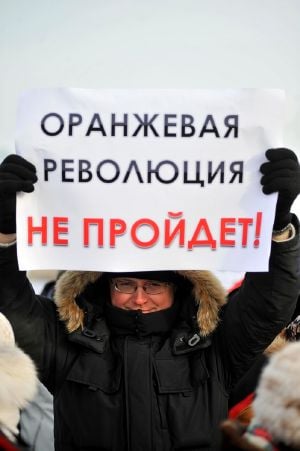
In March 2005 Ukrainian Foreign Minister Borys Tarasyuk stated that Ukraine would not be exporting revolution.[58] In the following years, the Orange Revolution had a negative connotation among pro-government circles in Belarus and Russia.[59]
During Alexander Lukashenko's inauguration (ceremony) as President of Belarus on January 22, 2011 Lukashenko vowed that Belarus would never have its own version of the Orange Revolution and Georgia's 2003 Rose Revolution.[60] In the aftermath of the 2011 South Ossetian presidential election (in December 2011) and during the protests following the 2011 Russian elections (also in December 2011) the Ambassador of South Ossetia to the Russian Federation Dmitry Medoyev and Russian Prime Minister Vladimir Putin and Putin's supporters named the Orange Revolution an infamous foreknowledge for their countries.[61][62][63] Putin also claimed that the organizers of the Russian protests in December 2011 were former (Russian) advisors to Yushchenko during his presidency and were transferring the Orange Revolution to Russia. A February 4, 2012 rally in favor of Putin was named the "anti-Orange protest". Former fellow Russian politician Sergey Glazyev stated in August 2013 that "a whole generation of diplomats and bureaucrats has appeared after the years of the 'orange' hysteria, who are carrying out an anti-Russian agenda" "creates an effect that Ukraine doesn't want", namely Ukrainian integration into the European Union and not into the Customs Union of Belarus, Kazakhstan and Russia.[64]
In 2016 the Russian newspaper Izvestia claimed, "in Central Asia weak regimes are already being attacked by extremists and 'Orange Revolutions'." Writing about the 2016 US presidential election Izvestia claimed "If the war-like, Russia-hating Hillary Clinton wins the US election, a third front could open up in the Caucasus; money will pour in to support terrorists, just like it did during the two Chechen wars. There could even be a fourth front in Central Asia, where weak regimes are already being attacked by extremists and 'Orange Revolutions'." [65]
In Russian nationalist circles the Orange Revolution has been linked with fascism because, albeit marginal, Ukrainian nationalist extreme right-wing groups and Ukrainian Americans (including Viktor Yushchenko's wife, Kateryna Yushchenko, who was born in the United States) were involved in the demonstrations; Russian nationalist groups see both as branches of the same tree of fascism. The involvement of Ukrainian Americans lead them to believe the Orange Revolution was steered by the CIA.[66]
Notes
- ‚ÜĎ 1.0 1.1 1.2 1.3 Abel Polese and Donnacha √ď Beach√°in, "The Colour Revolutions in the Former Soviet Republics: Ukraine," Routledge Contemporary Russia and Eastern Europe Series, 30-44. Retrieved September 1, 2022.
- ‚ÜĎ "Ukraine profile," BBC News, March 1, 2022. Retrieved September 1, 2022.
- ‚ÜĎ "Ukrainian Politics, Energy and Corruption under Kuchma and Yushchenko," Harvard University, March 7, 2008. Retrieved September 4, 2022.
- ‚ÜĎ "Georgiy Gongadze murder tied to late Ukrainian minister," BBC News, September 14, 2010. Retrieved September 4, 2022.
- ‚ÜĎ Roy Greenslade, "Ukrainian policeman gets life for murder of journalist," The Guardian, January 30, 2013. Retrieved September 4, 2022.
- ‚ÜĎ Taras Kuzio, "Ukraine's Orange Revolution: Causes and Consequences," University of Ottawa, April 28, 2005.
- ‚ÜĎ Joanna Konieczna, "The Orange Revolution in Ukraine. An Attempt to Understand the Reasons," Centre for Eastern Studies, OŇõrodek Studiow Wschodnich, July 13, 2005. Retrieved September 14, 2022.
- ‚ÜĎ Wojciech Stanistawski, "The Orange Ribbon: A Calendar of the Political Crisis in Ukraine," Centre for Eastern Studies, OŇõrodek Studiow Wschodnich, Warsaw, Autumn 2004.
- ‚ÜĎ Paul J. D'Anieri, Understanding Ukrainian Politics: Power, Politics, and Institutional Design (London, UK: Routledge, 2006, ISBN 978-0765618115), 117.
- ‚ÜĎ "Ukraine coalition born in chaos," BBC News, July 11, 2006. Retrieved September 1, 2022.
- ‚ÜĎ Anders Aslund and Michael A. McFaul, Revolution in Orange: The Origins of Ukraine's Democratic Breakthrough (Washington, DC: Carnegie Endowment for International Peace, 2006, ISBN 978-0870032219)
- ‚ÜĎ Adam Roberts and Timothy Garton Ash (eds.), Civil Resistance and Power Politics: The Experience of Non-violent Action from Gandhi to the Present (Oxford, UK: Oxford University Press, 2009, ISBN 978-0199552016), 345.
- ‚ÜĎ Paul Quinn-Judge and Yuri Zarakhovich, "The Orange Revolution," Time, November 28, 2004. Retrieved September 14, 2022.
- ‚ÜĎ Andrew Wilson, "Ukraine's 'Orange Revolution' of 2004: The Paradoxes of Negotiation", in Adam Roberts and Timothy Garton Ash (eds.), Civil Resistance and Power Politics: The Experience of Non-violent Action from Gandhi to the Present (Oxford, UK: Oxford University Press, 2009, ISBN 978-0199552016), 295‚Äď316.
- ‚ÜĎ Adrian Karatnycky, "Ukraine's Orange Revolution," Foreign Affairs, March-April 2005.
- ‚ÜĎ "Timeline: Battle for Ukraine," January 23, 2005. Retrieved September 1, 2022.
- ‚ÜĎ Veronica Khokhlova, "New Kids On the Bloc," The New York Times, November 26, 2004. Retrieved September 3, 2022.
- ‚ÜĎ Kamil Tchorek, "Protest grows in western city," The Times, November 26, 2004. Retrieved September 3, 2022.
- ‚ÜĎ "Yushchenko takes reins in Ukraine," BBC NEWS, January 23, 2005. Retrieved September 4, 2022.
- ‚ÜĎ USAID Report "Democracy Rising," (PDF) USAID, September 2005. Retrieved September 3, 2022.
- ‚ÜĎ "Supreme Court of Ukraine decision regarding the annulment of 21 November vote," Retrieved September 3, 2022.
- ‚ÜĎ "Yanukovych says presidential election scenario of 2004 won't be repeated in 2010," Interfax-Ukraine, November 27, 2009. Retrieved September 3, 2022.
- ‚ÜĎ "Results of Voting in Ukraine Presidential Elections 2004", Central Election Commission of Ukraine. Retrieved September 3, 2022.
- ‚ÜĎ Timeline: Battle for Ukraine BBC News, January 23, 2005. Retrieved September 29, 2022.
- ‚ÜĎ "Official CEC announcement of results as of 10 January 2005," Central Election Commission, March 12, 2005. Retrieved September 3, 2022.
- ‚ÜĎ Peter Finn, "In a Final Triumph, Ukrainian Sworn In," Washington Post, January 24, 2005. Retrieved September 3, 2022.
- ‚ÜĎ Orest Subtelny, Ukraine: A History 4th ed., (Toronto, CA: University of Toronto Press, 2009, ISBN 978-1442609914).
- ‚ÜĎ C. J. Chivers, "BACK CHANNELS: A Crackdown Averted; How Top Spies in Ukraine Changed the Nation's Path," The New York Times, January 17, 2005.
- ‚ÜĎ For question on ultimate source of orders and mobilization details see Jesse Paul Lehrke, The Transition to National Armies in the Former Soviet Republics, 1988‚Äď2005 (Oxfordshire, UK: Routledge, 2013, ISBN 978-0415688369), 188‚Äď189.
- ‚ÜĎ "How Yanukovich Forged the Elections. Headquarters‚Äô Telephone Talks Intercepted," Ukrainska Pravda, November 24, 2004. Retrieved September 3, 2022.
- ‚ÜĎ Abel Polese, Russia, the US, ‚Äúthe Others‚ÄĚ and the ‚Äú101 Things to Do to Win a (Colour) Revolution‚ÄĚ: Reflections on Georgia and Ukraine, Routledge, London, UK, October 26, 2011. Retrieved September 3, 2022.
- ‚ÜĎ Michael McFaul, "Transitions from Postcommunism," Journal of Democracy 16 (3) (2005): 12.
- ‚ÜĎ Joshua Goldstein, "The Role of Digital Networked Technologies in the Ukrainian Orange Revolution," Berkman Center Research Publication, 2007, 14.
- ‚ÜĎ Thomas Kalil, Harnessing the Mobile Revolution, The New Policy Institute, 2008, 14.
- ‚ÜĎ "Update: Return to 1996 Constitution strengthens president, raises legal questions," Kyiv Post, October 1, 2010.
- ‚ÜĎ "Court forbade Maydan after first tour of election," UNIAN, January 134, 2010. Retrieved September 3, 2022.
- ‚ÜĎ "Central Election Commission Candidate Results," CEC Ukraine, January 19, 2010. Retrieved September 3, 2022.
- ‚ÜĎ "Ukraine. Farewell to the Orange Revolution," EuropaRussia, January 19, 2010. Retrieved September 3, 2022.
- ‚ÜĎ "Ukraine election: Yanukovych urges Tymoshenko to quit," BBC News, February 10, 2010. Retrieved September 3, 2022.
- ‚ÜĎ "Yanukovych appeals to the nation, asks Tymoshenko to step down," Kyiv Post, February 10, 2010.
- ‚ÜĎ "Akhmetov: Ideals of 'Orange Revolution' won at election in 2010," Kyiv Post, February 26, 2010.
- ‚ÜĎ Yulia Tymoshenko, "Yulia Tymoshenko‚Äôs address to the people of Ukraine,", Yulia Tymoshenko official website, February 22, 2010. Retrieved September 3, 2022.
- ‚ÜĎ "Day of Freedom: here comes the end to revolutions," ForUm, November 23, 2011. Retrieved September 3, 2022.
- ‚ÜĎ "Yanukovych signs decree on new holiday replacing Ukrainian Independence Day," Kyiv Post, December 30, 2011.
- ‚ÜĎ "Yanukovych abolishes Day of Liberty on 22 November," Observer, December 30, 2011. Retrieved September 3, 2022.
- ‚ÜĎ "Yanukovych cancels Freedom Day on 22 Nov," Z I K, December 31, 2011. Retrieved September 3, 2022.
- ‚ÜĎ D'Anieri, 63.
- ‚ÜĎ Andrew Rettman, "EU endorses Ukraine election result," euobserver, February 8, 2010. Retrieved September 3, 2022.
- ‚ÜĎ World Digest, "International observers say Ukrainian election was free and fair," Washington Post, February 9, 2010. Retrieved September 3, 2022.
- ‚ÜĎ "European Parliament president greets Ukraine on conducting free and fair presidential election," Kyiv Post, February 9, 2010.
- ‚ÜĎ Andrej Lushnycky and Mykola Riabchuk, Ukraine on its meandering path between East and West (Pieterlin and Bern, SW: Peter Lang Publishers, 2009, ISBN 978-3039116072), 52.
- ‚ÜĎ Jan Maksymiuk, "Ukraine:Has Yushchenko Betrayed The Orange Revolution?" Radio Liberty, September 30, 2005. Retrieved September 3, 2022.
- ‚ÜĎ Tammy M. Lynch, "Independent standpoint on Ukraine: Dismissal of Prosecutor-General, Closure of Poroshenko Case Create New," Institute for the Study of Conflict, Ideology & Policy, Boston, MA, October 28, 2005. Retrieved September 3, 2022.
- ‚ÜĎ Pavel Polityuk and Richard Balmforth, "Yanukovich declared winner in Ukraine poll," The Independent, February 15, 2010. Retrieved September 4, 2022.
- ‚ÜĎ "Viktor Yanukovych sworn in as Ukraine president," BBC News, February 25, 2010. Retrieved September 4, 2022.
- ‚ÜĎ Julia Lugovska, "The upcoming parliamentary elections in Ukraine [Summary], WSN, October 23, 2012. Retrieved September 3, 2022.
- ‚ÜĎ "Q&A:Ukrainian parliamentary election," BBC News, October 23, 2012. Retrieved September 4, 2022.
- ‚ÜĎ Taras Kuzio, "BEREZOVSKY HOPES TO SELL ORANGE REVOLUTION TO RUSSIA," Eurasia Daily Monitor 2(54), March 17, 2005. Retrieved September 3, 2022.
- ‚ÜĎ Taras Kuzio, "Ukraine is Not Russia:Comparing Youth Political Activism," SAIS Review 26(2), Summer‚ÄďFall 2006. Retrieved September 14, 2022.
- ‚ÜĎ "Lukashenko Growls at Inauguration," The Moscow Times, January 24, 2011. Retrieved September 14, 2022.
- ‚ÜĎ "Putin calls 'color revolutions' an instrument of destabilization," Kyiv Post, December 15, 2011.
- ‚ÜĎ Interfax-Ukraine, "'Orange' methods will fail in South Ossetia," Kyiv Post, December 2, 2011.
- ‚ÜĎ "Russians Rally as Putin Hints Reforms, Warns of Regime Change," Sputnik International, February 4, 2012. Retrieved September 3, 2022.
- ‚ÜĎ "Putin‚Äôs aide calls opinion that all Ukrainians want European integration 'sick self-delusion'," Interfax-Europe, August 21, 2013. Retrieved September 15, 2022.
- ‚ÜĎ "Russian media's love affair with Trump," BBC news, November 2, 2016. Retrieved September 4, 2022.
- ‚ÜĎ Andreas Umland, "New Extremely Right-Wing Intellectual Circles in Russia: The Anti-Orange Committee, the Isborsk Club and the Florian Geyer Club," International Relations and Security Network, August 5, 2013. Retrieved September 3, 2022.
ReferencesISBN links support NWE through referral fees
- Anders Aslund and Michael A. McFaul. Revolution in Orange: The Origins of Ukraine's Democratic Breakthrough. Washington, DC: Carnegie Endowment for International Peace, 2006. ISBN 978-0870032219
- Chivers, C. J. "BACK CHANNELS: A Crackdown Averted; How Top Spies in Ukraine Changed the Nation's Path," The New York Times, January 17, 2005. Retrieved September 3, 2022.
- D'Anieri, Paul A. Understanding Ukrainian Politics: Power, Politics, and Institutional Design. London, UK: Routledge, 2006. ISBN 978-0765618115.
- Finn, Peter. "In a Final Triumph, Ukrainian Sworn In," Washington Post, January 24, 2005. Retrieved September 3, 2022.
- Goldstein, Joshua. "The Role of Digital Networked Technologies in the Ukrainian Orange Revolution," Berkman Center Research Publication, 2007.
- Greenslade, Roy. "Ukrainian policeman gets life for murder of journalist," The Guardian, January 30, 2013. Retrieved September 4, 2022.
- Kalil, Thomas. "Harnessing the Mobile Revolution," The New Policy Institute, 2008.
- Karatnycky, Adrian. "Ukraine's Orange Revolution," Foreign Affairs, March-April 2005.
- Khokhlova, Veronica. "New Kids On the Bloc," The New York Times, November 26, 2004. Retrieved September 3, 2022.
- Konieczna, Joanna. "The Orange Revolution in Ukraine. An Attempt to Understand the Reasons," Centre for Eastern Studies, OŇõrodek Studiow Wschodnich, July 13, 2005. Retrieved September 14, 2022
- Kuzio, Taras. "Ukraine's Orange Revolution: Causes and Consequences," University of Ottawa, April 28, 2005.
- Kuzio, Taras. "Ukraine is Not Russia:Comparing Youth Political Activism," SAIS Review 26(2), Summer‚ÄďFall 2006. Retrieved September 14, 202.
- Lehrke, Jesse Paul. The Transition to National Armies in the Former Soviet Republics, 1988‚Äď2005. Oxfordshire, UK: Routledge, 2013. ISBN 978-0415688369
- Lugovska, Julia. "The upcoming parliamentary elections in Ukraine [Summary], WSN, October 23, 2012. Retrieved September 3, 2022.
- Lushnycky, Andrej, and Mykola Riabchuk. Ukraine on its meandering path between East and West. Pieterlin and Bern, SW: Peter Lang Publishers, 2009. ISBN 978-3039116072
- Lynch, Tammy M. "Independent standpoint on Ukraine: Dismissal of Prosecutor-General, Closure of Poroshenko Case Create New," Institute for the Study of Conflict, Ideology & Policy, Boston, MA, October 28, 2005. Retrieved September 3, 2022.
- Maksymiuk, Jan. "Ukraine:Has Yushchenko Betrayed The Orange Revolution?" Radio Liberty, September 30, 2005. Retrieved September 3, 2022.
- McFaul, Michael. "Transitions from Postcommunism," Journal of Democracy 16 (3) (2005): 12.
- Polese, Abel. Russia, the US, ‚Äúthe Others‚ÄĚ and the ‚Äú101 Things to Do to Win a (Colour) Revolution‚ÄĚ: Reflections on Georgia and Ukraine, Routledge, London, UK, October 26, 2011. Retrieved September 3, 2022.
- Polese, Abel. and Donnacha √ď Beach√°in. "The Colour Revolutions in the Former Soviet Republics: Ukraine," Routledge Contemporary Russia and Eastern Europe Series, 30-44. Retrieved September 1, 2022.
- Polityuk, Pavel, and Richard Balmforth. "Yanukovich declared winner in Ukraine poll," The Independent, February 15, 2010. Retrieved September 4, 2022.
- Quinn-Judge, Paul, and Yuri Zarakhovich. "The Orange Revolution," Time, November 28, 2004. Retrieved September 14, 2022.
- Rettman, Andrew. "EU endorses Ukraine election result," euobserver, February 8, 2010. Retrieved September 3, 2022.
- Roberts, Adam, and Timothy Garton Ash (eds.). Civil Resistance and Power Politics: The Experience of Non-violent Action from Gandhi to the Present (Oxford, UK: Oxford University Press, 2009. ISBN 0199552010
- Stanistawski, Wojciech, "The Orange Ribbon: A Calendar of the Political Crisis in Ukraine," Centre for Eastern Studies, OŇõrodek Studiow Wschodnich, Warsaw, Autumn 2004.
- Subtelny, Orest, Ukraine: A History 4th ed., Toronto, CA: University of Toronto Press, 2009, ISBN 978-1442609914
- Tchorek, Kamil. "Protest grows in western city," The Times, November 26, 2004. Retrieved September 3, 2022.
- Tymoshenko, Yulia. "Yulia Tymoshenko’s address to the people of Ukraine,", Yulia Tymoshenko official website, February 22, 2010. Retrieved September 3, 2022.
- Umland, Andreas. "New Extremely Right-Wing Intellectual Circles in Russia: The Anti-Orange Committee, the Isborsk Club and the Florian Geyer Club," International Relations and Security Network, August 5, 2013. Retrieved September 3, 2022.
Further reading
- D'Anieri, Paul (ed.). Orange Revolution and Aftermath: Mobilisation, Apathy, and the State in Ukraine. Baltimore, MD: Johns Hopkins University Press, 2011. ISBN 978-0801898037
- Krushelnycky, Askold. An Orange Revolution: A Personal Journey Through Ukrainian History. New York, NY: Random House, 2006. ISBN 978-0436206238
- Tiryshkina, Tetyana. The Orange Revolution in Ukraine ‚Äď a Step to Freedom. Morrisville, NC: Lulu Press, 2007. ISBN 978-1847538574
- Wilson, Andrew. Ukraine's Orange Revolution. New Haven, CT: Yale University Press, 2006. ISBN 0300112904.
External links
All links retrieved November 17, 2022.
- Orange Winter, a feature documentary about the Orange revolution by Andrei Zagdansky.
- "Role of Internet-based Information Flows and Technologies in Electoral Revolutions:The Case of Ukraine’s Orange Revolution", Lysenko, V.V., and Desouza, K.C., First Monday, 15 (9), 2010.
- "The Economic Policy of Ukraine after the Orange Revolution," by Anders √Öslund.
Credits
New World Encyclopedia writers and editors rewrote and completed the Wikipedia article in accordance with New World Encyclopedia standards. This article abides by terms of the Creative Commons CC-by-sa 3.0 License (CC-by-sa), which may be used and disseminated with proper attribution. Credit is due under the terms of this license that can reference both the New World Encyclopedia contributors and the selfless volunteer contributors of the Wikimedia Foundation. To cite this article click here for a list of acceptable citing formats.The history of earlier contributions by wikipedians is accessible to researchers here:
The history of this article since it was imported to New World Encyclopedia:
Note: Some restrictions may apply to use of individual images which are separately licensed.

